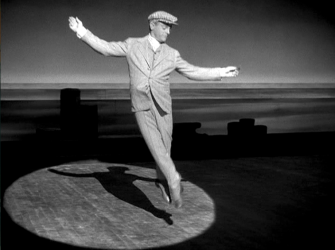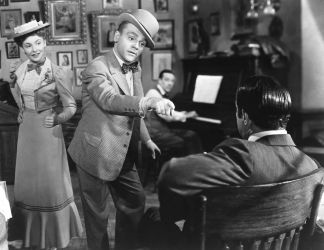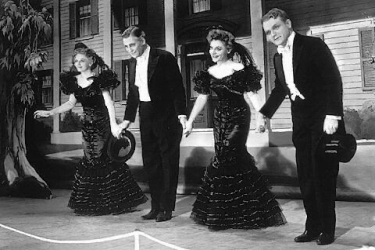Our Independence Day was a musical extravaganza with Yankee Doodle Dandy on a double-bill with The Music Man and, boy-oh-boy, that’s a lot of music. I had never seen Cagney’s brilliant performance, and his mimicry of George M. Cohan’s dance moves may be the only genuinely accurate part of this highly fictionalized (yet delightful) take on the great Irish-American’s life. At first I was suspicious. If you don’t know (and I didn’t), this movie is narrated by Cagney-as-Cohan to FDR, with Cohan in the last year of his 64 year life. (Though, presumably they didn’t know that.)

Light on his feet, for a dirty rat.
Anyway, Cagney as 64-year-old Cohan dances just like Cagney as 20-year-old Cohan, which seems unlikely, especially in 1942 when 64 was pretty hard won (and about the average life expectancy) but you can find videos of old Cohan and damned if the man didn’t dance like a man who was just made up to look old. (Although, unlike Cagney, he really did look old.) Cagney pretty much nails his sing-speak style, as well.
The music, of course, is woven into American history, somewhat to its detriment. That is, like Stephen Foster’s work, it’s so ingrained as to seem trite but then you realize, holy cow: This guy wrote “Over There” and “It’s A Grand Old Flag”, with the latter in particular being the sort of song one can imagine just evolving. But it didn’t! And in fact the original title—this isn’t mentioned in the movie—was “It’s A Grand Old Rag,” which I kind of like better. (I like the idea of recognizing that it’s just a piece of cloth but at the same time represents something much greater.) Other songs from the film by Cohan are “Harrigan”, “Give My Regards To Broadway”, “So Long, Mary” and “Molly Malone”.

H! A! Double-R! I just wanted to point out that even here is great blocking.
Mixed in with these are classic Americana like “Battle Hymn of the Republic”, “Auld Lang Syne” (OK, it’s Scottish but we appropriated it), “My Country ’tis of Thee” and so on. Because above all, this is a movie about America and from a time when Broadway was a part of America instead of the Bolshevik enclave it is now. The story of Cohan’s life, as presented here, is the story of how immigrants can come to this country and have a kid who doesn’t just survive, doesn’t just succeed, but actually captures the national imagination for decades.
Though, as the movie points out, all fame is fleeting, and the new generation doesn’t know from Cohan’s classics (a little unlikely given my kids know quite a few of his songs) and are only into the fancy swing tunes, like “Jeepers Creepers” (1938). I guess it was more his shows (which he made mucho bank on) that were quickly forgotten—I hadn’t heard of them, but I’m more into the post-WWI, pre-WWII era—but such is the nature of live theater.

The Four Cohans, Hollywood Style
Anyway, the theme of this movie, beyond “America, Heck Yeah!” is the power of the family. Cohan (actually) got his start as part of The Four Cohans, where the other three Cohans consisted of his sister and parents. The movie shows him growing up, cocky to the point of arrogant and irascible enough to hurt The Four Cohans options for where they could play. So the family gets to stick beside him and he gets to sacrifice so they can succeed, and then he gets to succeed and then he gets to help them out, and then his parents get old and…oh, my, you get the picture.
Circle of life stuff. As trite as the music. But, as they say, everything true is trite, and if none of this actually happened, it’s a kind of idealization of the family life we all want. The sort of thing entertainment was made of before it got “real”: aspirational stuff. You wanna be there for your family and to know they’re there for you, and you’re willing to sacrifice because they have and will for you. Yeah, we all got choked up more than once.
Now, the only thing is: We’ve been sitting in the theater for over two hours at this point (well more because we got there early, and good thing, ’cause it was packed) and by the end were pretty “full” both cinematically and musically speaking. But The Music Man was next, and it’s a whopper (over 2 1/2 hours) and jammed with more music than even this. So the kids would be put to the test.

It truly is a Grand Old Rag.
